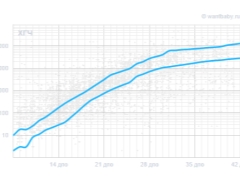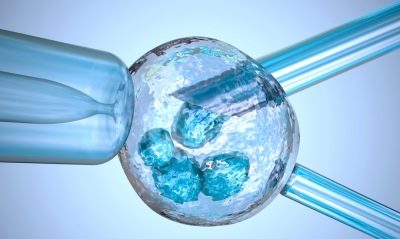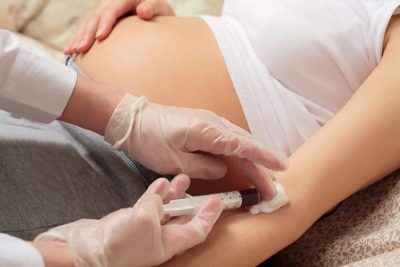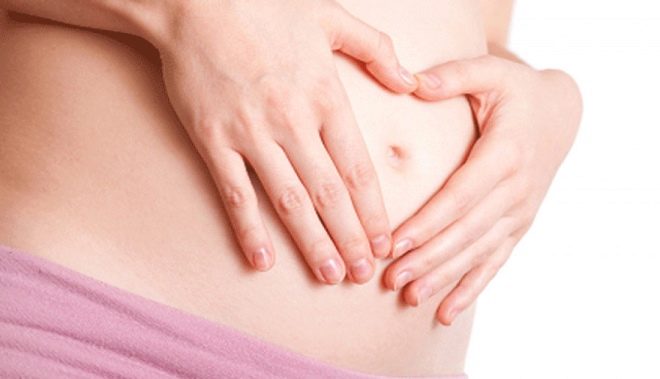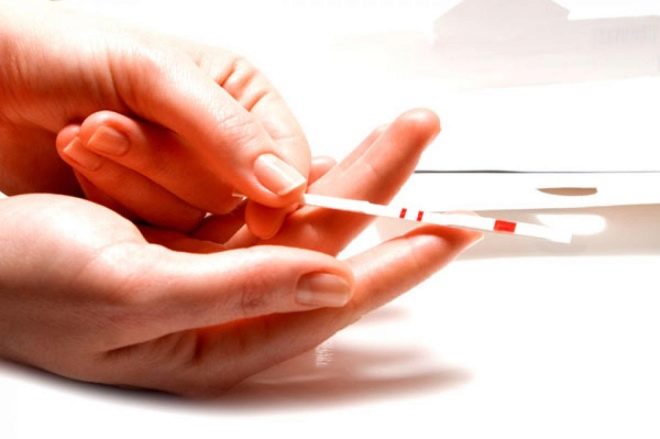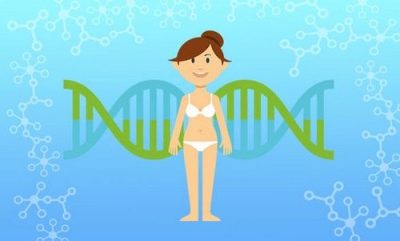Table of norms and growth of hCG on days after IVF
Human chorionic gonadotropin (hCG) is a hormone that is produced by the placenta, or, as it is also called, the "place" of the fetus during pregnancy. It belongs to the group of gonadotropic hormones and its biological structure is very similar to luteinizing and follicle-stimulating hormones.
This compound begins to be synthesized in the woman’s body several hours after fertilization. Further, the level of hCG concentration begins to gradually increase, and by 9-10 weeks of pregnancy, it reaches its maximum. After this period, a decrease in its concentration is recorded.
After IVF (in vitro fertilization), a detailed study of the dynamics of changes in hCG parameters is of great importance, as it helps to understand how successfully the implantation of a fertilized egg and the further development of the embryo go.
What indicators of hCG after IVF are considered the norm? What is the difference between the dynamics of hCG after IVF and as a result of pregnancy occurring naturally?
More on HCG
To better understand the basic principles of interpreting the data of the dynamics of hCG in the blood of a woman after IVF, it is necessary to have an idea of what kind of substance. This hormone is produced by embryonic shell cells. The increase in the content of CTG in the blood occurs immediately after the onset of pregnancy.. It is on this principle that pregnancy tests for home use work.
Later, regular registration of changes in the concentration of hCG in the blood of a woman will help the doctor observing pregnancy, identify possible pathologies of pregnancy at an early stage of development and promptly determine the tactics of their elimination.
Methods for determining the indicator
With the help of biochemical laboratory tests, it is possible to track the nature of changes in the concentration of hCG in a woman’s body only 2 weeks after IVF. To do this, she needs to take a urine or blood sample, but the latter option is more informative biological material.
Usually, the blood for such a study is given by a woman during the first half of pregnancy with the regularity established by the doctor (the analysis is given on average at 2, 4, 7, 9, 12, 14, 17, 20 weeks).
If there is a need, then she will have to take the same tests during the second half of pregnancy. The result of each laboratory test will be listed in a special table, the purpose of which will be discussed in more detail below.
The objectives of the indicator and its dynamics
To monitor changes in the concentration of hCG in the blood or urine after in vitro fertilization is necessary for many reasons, but the main ones are:
- confirmation of pregnancy (by the presence of this hormone in the urine);
- identification of some aspects that help to more clearly see the nature of the course of pregnancy (depending on whether the level of the hormone increases and decreases);
- early detection of various pathologies of pregnancy before the appearance of characteristic symptoms.
If there is a persistent negative change in the level or a slow increase in the concentration of hCG in the blood, thanks to this data, the gynecologist may suspect a missed abortion, a threat of spontaneous abortion, or an ectopic pregnancy.
One of the most reliable ways to not only confirm pregnancy, but also its exact term is the determination of hCG in the blood. In the body of a healthy woman, this hormone is produced only when pregnancy occurs, therefore its presence in the blood or urine clearly shows whether the pregnancy occurred or not in the earliest periods when other laboratory methods and instrumental diagnostic studies can confirm it or disprove it only after a certain time.
The content of hCG in a non-pregnant woman is 0-5 mIU / l. Test strips show a positive result (when the pregnancy has come) at a concentration of 10-25 mIU / L. On ultrasound, the fetus will become visible only when the level of hCG content reaches 1000 mIU / l.
If pregnancy occurs naturally, then in most cases it is not necessary for the attending physician to track the dynamics of changes in the concentration of the “pregnancy hormone”. Another thing, if fertilization occurred as a result of IVF, then the level of hCG indicates how successfully the implantation of the fertilized cell into the uterine mucosa occurred and how the development of the embryo occurs.
Closely monitoring the increase in the content of hCG during pregnancy is necessary in order to make sure that all physiological processes characteristic of this state are normal, and to detect and correct any pathology of pregnancy in time.
With a more detailed study of the above scheme, it becomes clear that the most rapid increase in the concentration of hCG in a woman in a “position” is in the first month of pregnancy.
The level of hormone every 2-3 days is almost doubled. The maximum concentration of hCG in the blood of the expectant mother is recorded at about the 11th week of pregnancy. After reaching the "peak" level of hCG gradually begins to decrease.
Due to the functioning of the placenta throughout pregnancy, the amount of hCG in the blood can be determined at any time. If the results of laboratory tests clearly show that hCG decreases too rapidly, such dynamics may indicate premature aging of the placenta.
If it is marked by a too sharp “recession” or a complete lack of “growth”, then this symptom may indicate a threat of spontaneous abortion or missed abortion.
Concentration changes
As already mentioned, there are indicators of norms and growth of hCG after embryo implantation as a result of IVF. Important in determining these data is the age of embryos: they can be three-day and five-day.
Daily monitoring of hCG dynamics is performed using the table below. It allows you to understand how normally a pregnancy proceeds as a result of in vitro fertilization.
Judging by the numerous reviews of women who have gone through IVF, we can say that the tables help not only the attending physician to observe the condition of the pregnant woman, but also the woman herself to take part in the direct control of all clinical processes.
Table of contents of hCG after IVF by day
After IVF or repeated cryoprevention of embryos into the uterine cavity, the woman for two weeks is tormented by the question whether this attempt to become pregnant succeeds, so she is looking for any opportunity to determine whether there is a pregnancy. To do this, she can purchase a pregnancy test for home use or pass the analysis for the content of hCG.
In order to correctly interpret laboratory data, there is a special table showing the rate of hCG content on days after IVF, if, of course, the procedure was successful, and the embryo managed to implant in the uterine mucosa.
Day after IVF | HCG for 3-day embryos | HCG for five day embryos | Minimum HCG | Medium hCG | Maximum hCG |
7 | 4 | 2 | 2 | 4 | 10 |
8 | 5 | 3 | 3 | 7 | 18 |
9 | 6 | 4 | 3 | 11 | 18 |
10 | 7 | 5 | 8 | 18 | 26 |
11 | 8 | 6 | 11 | 28 | 45 |
12 | 9 | 7 | 17 | 45 | 65 |
13 | 10 | 8 | 22 | 73 | 105 |
14 | 11 | 9 | 29 | 105 | 170 |
15 | 12 | 10 | 39 | 160 | 270 |
16 | 13 | 11 | 68 | 260 | 400 |
17 | 14 | 12 | 120 | 410 | 580 |
18 | 15 | 13 | 220 | 650 | 840 |
19 | 16 | 14 | 370 | 980 | 1300 |
20 | 17 | 15 | 520 | 1380 | 2000 |
21 | 18 | 16 | 750 | 1960 | 3100 |
22 | 19 | 17 | 1050 | 2680 | 4900 |
23 | 20 | 18 | 1400 | 3550 | 6200 |
24 | 21 | 19 | 1830 | 4650 | 7800 |
25 | 22 | 20 | 2400 | 6150 | 9800 |
26 | 23 | 21 | 4200 | 8160 | 15600 |
27 | 24 | 22 | 5400 | 10200 | 19500 |
28 | 25 | 23 | 7100 | 11300 | 27300 |
29 | 26 | 24 | 8800 | 13600 | 33000 |
30 | 27 | 25 | 10500 | 16500 | 40000 |
31 | 28 | 26 | 11500 | 19500 | 60000 |
32 | 29 | 27 | 12800 | 22600 | 63000 |
33 | 30 | 28 | 14000 | 24000 | 68000 |
34 | 31 | 29 | 15500 | 27200 | 70000 |
35 | 32 | 30 | 17100 | 31000 | 74000 |
36 | 33 | 31 | 19000 | 36000 | 78000 |
37 | 34 | 32 | 20500 | 39500 | 83000 |
38 | 35 | 33 | 22000 | 45000 | 87000 |
39 | 36 | 34 | 33000 | 51000 | 93000 |
40 | 37 | 35 | 25000 | 58000 | 108000 |
It is possible to determine with absolute certainty how successful IVF was, no earlier than two weeks after the procedure. If the concentration of hCG in the blood is not less than 100 mIU / l, then it can be said with confidence that the pregnancy has come, and the chances of its successful completion are quite high.
A low pregnancy hormone level (less than 25 mIU / L) indicates that the desired pregnancy has not occurred. Also, a similar indicator can be obtained if the analysis is taken too early.
If the obtained data on the concentration of hCG in the blood of a woman in relation to the accepted norms are borderline, the result of the analysis is considered questionable.
In addition, such data may indicate the occurrence of ectopic or tubal pregnancy, but as a result of IVF, this type of pathology is extremely rare.
How to interpret the data tables?
To determine the rate of content of hCG, you must use some numerical data:
- Date of study. It is necessary to determine the age of the embryo (3 or 5 days), and then calculate by the number of days after the embryo transfer. Next you need to verify the resulting value in the table.
- To determine the exact number of days after the procedure, it is worth using a column of the table with the desired age of the embryo. If this is not taken into account, the value of the hCG level will be questionable.
- It must be remembered that in the last column of the table of growth of hCG are averaged figures. Therefore, if you notice any inconsistencies, then you should not make hasty conclusions, but rather ask for help in the interpretation of a specialist.
Signs after IVF with an increase in hCG
It is necessary to know that there are no absolute clinical signs indicating an increase in the level of hCG in a woman’s body. Even if she feels some changes in her condition, this does not mean pregnancy.
To conduct an analysis that determines the level of hCG in the blood, it is advisable not earlier than two weeks after embryo transfer. The increase in the concentration of hCG in the blood is controlled with the help of special laboratory tests, which must be carried out almost daily.
If the doctor suspects an unsuccessful attempt at artificial insemination, he may order monitoring of the hCG level with the aim of prescribing supportive therapy for the repeated successful implantation of the embryo.
In this case, the patient will have to take the drugs and inject injections again, depending on the doctor's prescriptions.
Dynamics of hCG in multiple pregnancies
The content of hCG in the case of multiple pregnancies resulting from in vitro fertilization is significantly higher than with single-fetus. This is explained by the fact that hormone production occurs at once by several placentas (2 - for twins, 3 - for triplets, etc.). Therefore, the indicator of the content of hCG in the first study of 2 or three times may exceed the norm.
After the fact of having a multiple pregnancy is accurately established, the normal level of hCG will be calculated according to the principle: norm for singleton pregnancy multiplied by the number of fetuses.
Dynamics Research Methods
In order to control the state of her body, a woman after IVF may resort to alternative methods for determining the concentration of hCG. Such methods include the following activities:
- Control of basal measurements. Increased body temperature often indicates the success of the procedure of artificial insemination. However, the data from this study are very subjective, therefore, they require clarification by a specialist.
- Conduct indicator test. The dynamics of increasing the concentration of hCG in the blood can be detected using a special indicator test. But, as in the previous case, this is not a sufficient reason to claim that the pregnancy has occurred. In this case, additional research is required;
- Subjective feelings of a woman. When pregnancy occurs, many women note some changes in their bodies, even in the early period of gestation. For example, a woman may note the absence of characteristic signs of premenstrual syndrome. However, these are the same subjective signs, the accuracy of which must be confirmed by the results of laboratory or instrumental studies.
It is correct to evaluate the data on the change in the concentration of hCG in a woman’s body only by a doctor observing pregnancy, so you should trust him.
The program of in vitro fertilization in EMC, see the following video.
